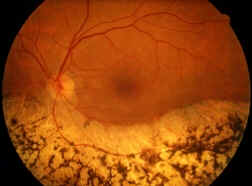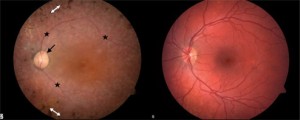Usher’s Syndrome Definition
Page Contents
- 1 Usher’s Syndrome Definition
- 2 Usher’s Syndrome ICD10 Code
- 3 Usher’s Syndrome History
- 4 Usher’s Syndrome Incidence
- 5 Usher’s Syndrome Types
- 6 Usher’s Syndrome Causes
- 7 Usher’s Syndrome Symptoms
- 8 Usher’s Syndrome Diagnosis
- 9 Usher’s Syndrome Differential Diagnosis
- 10 Usher’s Syndrome Treatment
- 11 Usher’s Syndrome and Genetic Testing
- 12 Usher’s Syndrome Management
- 13 Usher’s Syndrome Complications
- 14 Usher’s Syndrome Prognosis
- 15 Usher’s Syndrome Prevention
- 16 Usher’s Syndrome Support
It is an inherited condition that leads to acute loss of hearing and retinitis pigmentosa, a disease of the eye that leads to worsening of vision over a period of time. It is a most common disorder that affects both vision and hearing of sufferers.
The disorder is also known by the following names:
- Hallgren syndrome
- Usher-Hallgren syndrome
- Dystrophia retinae dysacusis syndrome
- Retinitis pigmentosa-dysacusis syndrome
Usher’s Syndrome ICD10 Code
The ICD10 Code for this disorder is H35.5.
Usher’s Syndrome History
The disorder has been named after a British physician named Dr. Charles Usher who published studies on the disorder for the first time in the early 20th century. It was Usher who indicated that the condition might be congenital in nature, thus laying the basis for further study.
Usher’s Syndrome Incidence
The condition can be found in around 3-6% of all children who are deaf as well as another 3-6% kids who have acute difficulties in perceiving auditory sensations. In developed nations, such as the United States, the disease affects around four out of every 100,000 babies.
Usher’s Syndrome Types
The condition has been categorized into the following three types:
Picture 1 – Usher’s Syndrome
Type I
Individuals affected by this disease are deaf ever since they are born and have acute problems in maintaining balance from a tender age. They usually develop vision problems by the time they are 10 years old and eventually become blind.
This form is known as USH1.
Type II
Those with this type of the syndrome have mild to severe loss of hearing but have normal balance. They generally develop vision problems in their early teenage years. However, the problems progress more gradually than in Type I.
This type is referred to as USH2.
Type III
People with this type of the disease have normal hearing and close-to-normal balance. However, they develop vision problems at a later stage followed by loss of hearing.
This form is called USH3.
Subtypes within USH1, USH2 or USH3 are indicated by using the names USH1a or USH2b.
In the United States, the types I and II are reported to be the most common. Together, these two forms account for around 90-95% of all cases of children affected by Usher’s Syndrome.
Usher’s Syndrome Causes
This is a genetic condition and is inherited in an autosomal recessive pattern. This indicates that a child will only develop this disorder if he or she inherits a copy of the gene responsible for it from both parents. In the majority of cases, each parent is found to carry only one copy of the defective Usher’s Syndrome gene. Naturally, they do not have the condition themselves and are unaware as a result that they are carriers.
A variety of different genes have been found that can possibly contribute to the development of this syndrome. These genes usually help in proper functioning of the cochlea in the inner ear and the retina in the eye. In kids affected by this condition, one or more of these genes is found to be defective.
Usher’s Syndrome Symptoms
The signs and symptoms of this disorder depend on the form that an individual suffers from. However, the symptoms usually include the following problems:
- Speech difficulties
- Balance problems
- Loss of hearing, which causes deafness
- Loss of vision, which results in blindness in the later stages
The loss of sight in patients results from an ocular condition known as Retinitis Pigmentosa (RP) which causes a slow, progressive decrease in visual capabilities. The first sign of RP is night blindness, which is followed by narrowing of side vision resulting in what is known as “Tunnel Vision.”
The loss of hearing is sensori-neural deafness, a problem in the auditory nerve or the inner ear. An individual with Usher’s Syndrome suffers from hearing loss from birth. Certain forms of this syndrome affect the development of the vestibular organs located in the inner ear which is responsible for sense of space and balance.
Usher’s Syndrome Diagnosis
It is highly essential to conduct the diagnosis of this disease at an early stage. The earlier that parents become aware of the presence of the condition in their children, the faster they can seek medical treatment for the disorder. Then, children can be subjected to specialized educational training programs which can help them manage the loss of vision and hearing.
As this syndrome affects the vision, balance and hearing of sufferers, the diagnosis of the disease generally involves the assessment of all the three senses.
The assessment of the eyes may involve a visual field test to measure the peripheral vision of a person. An Electroretinogram (ERG) may be used to measure the electrical response of the light-sensitive cells of the eye. In some cases, patients may be subjected to a retinal examination to observe the retina as well as the other structures of the eye.
An audiologic or hearing assessment helps physicians measure how much loud auditory sensations can be before a person can hear them. An Electronystagmogram (ENG) evaluates involuntary ocular motions that can signify a problem in balance.
Usher’s Syndrome Differential Diagnosis
The symptoms of this condition are similar to that of another disorder, Congenital rubella. Doctors should ensure that the symptoms experienced and reported by sufferers are not the result of this birth condition.
Usher’s Syndrome Treatment
There is no treatment for this disorder. However, the faster it is diagnosed, the greater the number of steps that can be taken to help affected kids lead as normal a life as possible.
The best treatment for this disease involves detecting the condition at an early stage so that educational programs can be initiated as fast as possible. The exact nature of these programs depends on the seriousness of the loss of visual and hearing capabilities as well as the age and abilities of sufferers. The curative measures for the disorder include:
- Supportive listening devices
- Hearing aids
- Cochlear implants
- Communication services
- Other modes of communication, such as orientation and mobility training
- Training to live independently, which may involve auditory training, low-vision services and Braille instruction
Counseling may be helpful in improving the condition of sufferers. Genetic counseling is essential for the future family plans of an individual as well as his or her other family members.
Genetic therapy looks increasingly promising as a cure for Retinitis pigmentosa. However, this treatment is not likely to be used until after many years.
Certain ophthalmologists believe that the progression of RP may be slowed down or even stopped by administering patients with a high dose of Vitamin A Palmitate. This theory arises from the results a long-term medical trial that has been supported by the National Eye Institute and the Foundation for Fighting Blindness. On the basis of these results, researchers recommend that the majority of adult sufferers with the common types of RP should consume a daily supplement of 15,000 IU Vitamin A in a palmitate form under the strict monitoring of an eye care professional.
Usher’s Syndrome and Genetic Testing
So far, researchers have managed to find as many as eleven genetic loci to be responsible for the development of this disorder. Nine genes have been exactly pinpointed as the causes of the disease. These include:
- MY07A, USH1C, CDH23, PCDH15, SANS (For Type 1)
- USH2A, VLGR1, WHRN (For Type 2)
- USH3A (For Type 3)
As so many genes are involved in the occurrence of this syndrome, genetic tests are not carried out in a widespread manner for the disorder. Genetic testing is available for a few of the genes that have been identified to be responsible for this syndrome. For additional genes, Genetic testing may be available through clinical research studies.
Usher’s Syndrome Management
Although the condition cannot be cured, it can be managed. As blindness and deafness rarely arise together, the majority of physicians assume that individuals exhibiting both symptoms are actually patients of Usher’s Syndrome. If the condition is diagnosed at an early stage, before the loss of visual acuity begins, a patient has to be taught various techniques which can prove to be useful during the onset of total blindness.
Usher’s Syndrome Complications
The disorder can give rise to a number of complications, which include:
Picture 2 – Usher’s Syndrome Image
- Night blindness
- Complete blindness
- Total loss of hearing
The disease is also likely to have a negative impact on the psyche of patients. Due to the absence of proper treatment options for this condition, sufferers may experience frustration and feel isolated as they struggle to cope up with the disease.
Usher’s Syndrome Prognosis
The condition cannot be treated. However, patients can live a more or less active life with the disorder. Some activists in the blind and the deaf community have Usher’s Syndrome but live a fairly active existence. Living with the disorder can be extremely challenging, but possible.
Usher’s Syndrome Prevention
The condition cannot be prevented. Genetic counseling may help people with a family history of the disease who are planning to have children. Early diagnosis of the disorder and seeking treatment on an early basis can help patients avoid fast progression of the syndrome.
Usher’s Syndrome Support
Patients of this syndrome, and their family members, can seek essential information about the disorder from the following organizations:
NIDCD Information Clearinghouse
1 Communication Avenue
Bethesda, MD 20892-3456
Toll-free Voice: (800) 241-1044
Toll-free TTY: (800) 241-1055
Fax:(301) 770-8977
E-mail: [email protected]
National Eye Institute, National Institutes of Health
Building 10, Room 10N226
10 Center Drive
Bethesda, MD 20892
Phone: 301-496-3577
Fax: 301-402-1214
Email: [email protected]
If you suspect your child to be affected by this disease, seek medical treatment as soon as you can. Although the disorder cannot be cured, early treatment can help manage the disorder and avoid fast progression of the syndrome. Affected children can live a more or less normal life, despite the presence of the disease.
References:
http://www.bbc.co.uk/health/physical_health/conditions/ushers1.shtml
http://www.medicinenet.com/usher_syndrome/article.htm
http://www.patient.co.uk/doctor/Usher-Syndrome.htm
http://www.wisegeek.net/what-is-ushers-syndrome.htm


